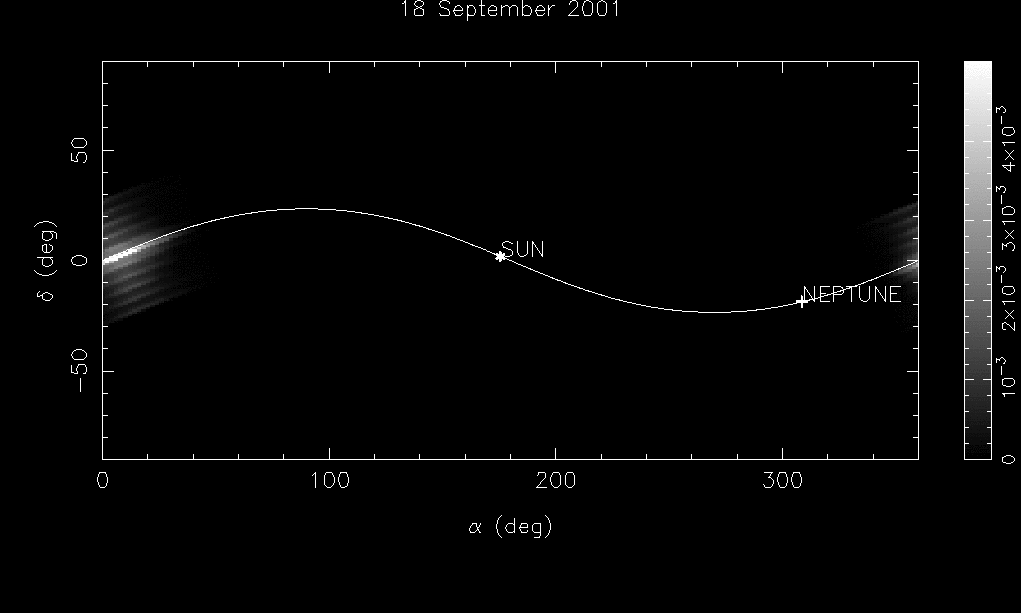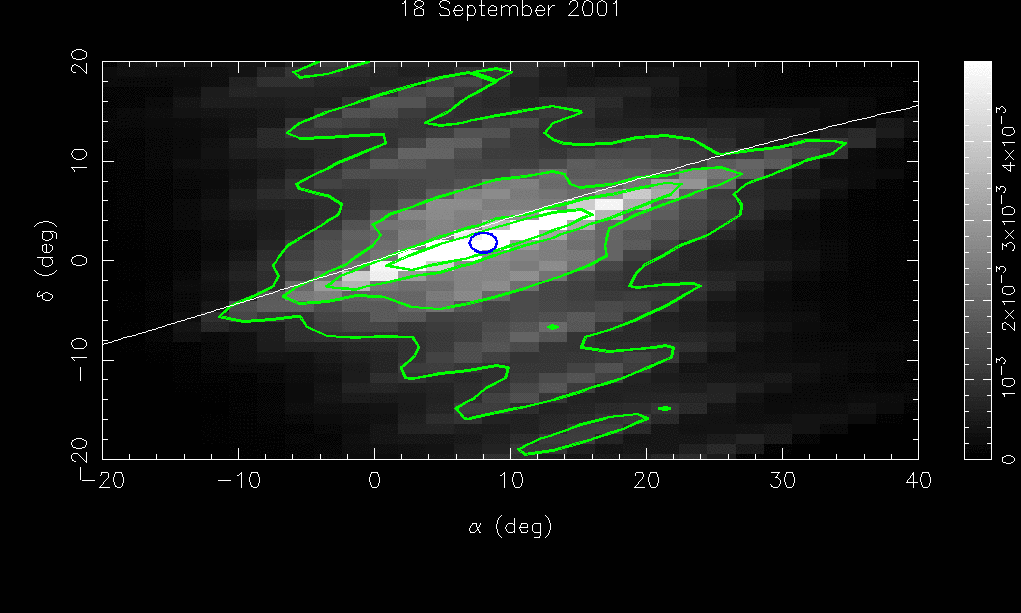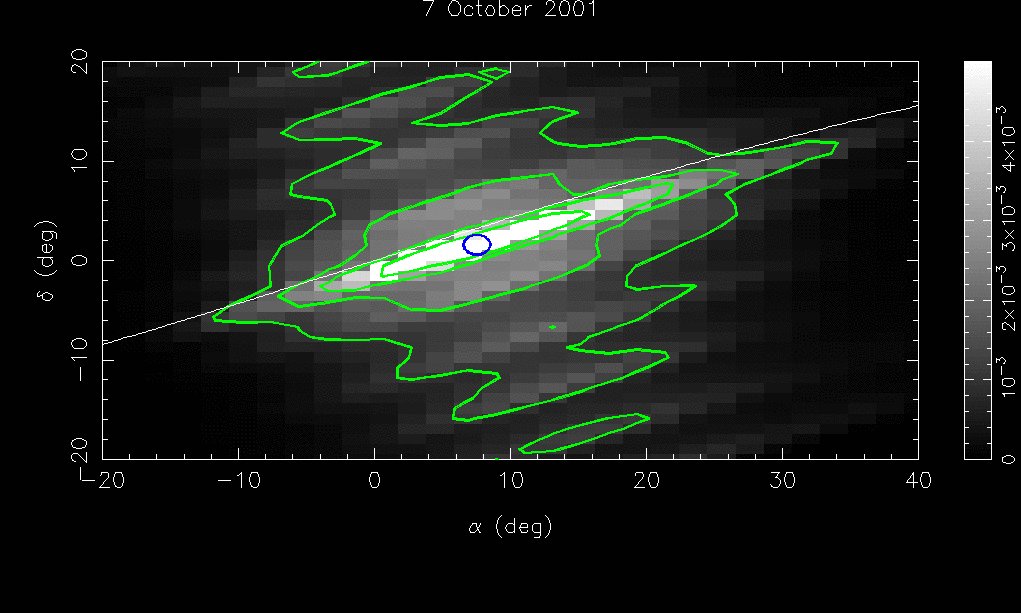Observation proposal: Search for the Trojans of Neptune
There must almost certainly exist populations of Trojans coorbiting with Saturn, Uranus, and Neptune, temporarily trapped from other reservoires. The comets from the scattered disk, and the comets leaking from the classical and resonant Kuiper belts can be captured on the tadpole orbits with large amplitudes, temporarly behaving as coorbital bodies. Neptune's transient Trojan population should be larger than the ones of Saturn and Uranus because the ecliptic comets are more numerous at 30 AU than closer to the sun.An interesting question is whether the permanent Trojan populations exist at Saturn, Uranus, and Neptune. By permanent Trojan populations we mean bodies which accreeted or were trapped on the tadpole orbits in early stages of the solar system formation, and permanently reside on the tadpole orbits. In order a planet currently has a substantial population of the permanent Trojans, the tadpole orbits must be dynamically stable over 4 Gy, so that the formed objects survive as coorbitals over the age of the planet.
We have studied the long-term stability of the Trojan orbits. For Saturn and Uranus, the stable orbits are rare. Only ~1-2% of test particles on tadpole orbits survive 4 Gy. As Saturn's and Uranus' Trojans are also very unstable when the planets migrate (Gomes 1998), we do not believe that substantial permanent populations of Saturn's and Uranus' Trojans currently exist (let observations prove us wrong). For this reason we focus on the Neptune's Trojans.
The Neptune's tadpole orbits are stable on 4 Gy in a 0.3 AU interval about the L4 and L5 points, unless the eccentricity is larger than ~0.1 or the inclination exceeds ~25 degrees. Comparing with the Jupiter's Trojans, the stability region of the Neptune's Trojans is equally large in the semimajor axis and the inclination, and is smaller in the eccentricity. Nevertheless, if the observed Jupiter's Trojans with their current e,i were displaced to the Neptune's coorbital space, about 3/4 of them would be perfectly stable. Moreover, Gomes (1998) has shown that the 7 AU smooth radial migration of Neptune does not drastically reduce the pre-existing population. This is due to the fact that the libration amplitudes of coorbitals do not change much with the planet's semimajor axis drift (Fleming and Hamilton 2000).
The behavior of Neptune's Trojans in the scenarios of the non-smooth Neptune radial migration or the expulsion of Neptune from the Jupiter-Saturn zone (Thommes et al.) have not yet been studied. It is likely that the pre-existing population of the Neptune's Trojans could have been substanially reduced (if not completely removed) if either of the two scenarios occured. On the other hand, the Neptune's Trojans could have been captured in the period coinciding with the Neptune's orbit migration, or later. The growth of the Neptune's mass could have also played an important rule in trapping bodies and reducing their amplitudes - thus stabilizing them. Anyway, if the Neptune's Trojans existed shortly after the outer giant planets emerged at that current locations, their formation mechanism very probably differed from the formation of the Jupiter's Trojans, where the gas envelope collapse played an important rule (Marzari and Scholl). It is evident that the future observational evidence for the Trojan population of Neptune would set important constraint on the formation of the outer planets.
We suggest an observational survey searching for the Neptune's Trojans close to the L4 and L5 Lagrangian points of the planet. To facilitate such survey, we compute the surface densities of the model population of the Neptune's Trojans. Our model population consists of 96 test bodies -- the remnant of the dynamically eroded initial population over 4 Gy. These bodies initially uniformly sample the libration amplitudes, inclinations, and eccentricities. More realistic models should (1) sample inclinations differently (the uniform-in-sin(i) distribution), (2) sample amplitudes according to the larger volume of the large amplitude orbits. and (3) account for a gaussian-type initial excitation of eccentricities and inclinations. If any of these effects were taken into account, the `cloud' of the maximum sky density of the Neptune's Trojans would be more dispersed than the one shown in the following figures. Although we could compensate for (1) and (2) weighting each orbit according to the assumed distribution, we do not do so because of the low resolution of our model population (5 deg in the inclination), which weakens the applicability of this technique. Instead, we decided to run an additional simulation, where the initial orbital elements were chosen more realistically, and the resolution of inclinations were better. We hope to update the following figures soon.
Theoretically, if i is distributed uniformly in sin(i), the inclination profile of the sky density should be almost flat at very small inclinations (i<i_), and should be a linearly decreasing function of the inclination at i>i_ , where i_ is the typical amplitude of the secular osciallations of the inclination (~1 deg in the case of the Neptune's Trojans).
The following figure shows the sky density of the Neptune's L4 Trojans
on 9/18/2001. The L4 Trojans form a cloud near (0,0). (Brett: make
sure that the following figure makes sense!):

Zooming on the cloud of the maximum sky density of the Neptune's L4
Trojans on 9/18/2001 :

The white line is the ecliptic, the green lines show the countours of the sky density. The blue circle is centered at a point on Neptune's orbit, 60 degrees in front of the Neptune as viewed from the Sun, on the instantaneous Neptune's orbital plane. This is probably the best place to look at. It is located rec=8.00526 deg , dec=1.81282 deg. If covering a larger sky area, it is good to stay within the innermost contour, and shot several images parallel to the ecliptic. Note that the peak of the maximum sky density is offset from the ecliptic by ~1.5 deg because of the inclination of the Neptune's orbit. It is however uncertain whether the Neptune's Trojans should be as tightly clustered as the figure shows due to the uncertainities of our model. Still, the blue circle is very probably the best place to look at. The shading in this figure represents the probability to have a Trojan localized in 1 square degree. This probability is normalized to the total population of 1 Trojan at the L4 point with Neptune.
On October 7, 2001, the situation is the following:

This sky density plot shows the same features as the one on 18 Sept
2001 (there are only 20 days between the two dates). There is a very small
shift of the whole structure to the left, along the ecliptic.
The best place to look at is rec=7.53036 deg, dec=1.59644 deg (the
center of the blue circle). On October 10, 2001, the situation repeats.
Shoting the image at rec=7.45138 deg, dec=1.57285 deg at this date should
be the best strategy.
To summarize, the following table shows where the largest sky densities
of the Neptune's L4 Trojans occur.
| DATE | REC (deg) | DEC (deg) |
| 18 September 2001 | 8.00526 | 1.81282 |
| 7 October 2001 | 7.53036 | 1.59644 |
| 10 October 2001 | 7.45138 | 1.57285 |
Luke estimated from Jewitt et al. (2000) , assuming the size distribution
and the total number of the Neptune's Trojans similar to the ones of the
Jupiter Trojans, that there might exist ~20 Neptune's L4 Trojans
with the V magnitude at opposition > 23.8, and ~400 Neptune's L4 Trojans
with Vmag > 25.8. If so, and since the probability at the suggested locations
is ~0.01 per square degree, there are
0.01*20 = 0.2 Neptune's L4 Trojans per square degree with Vmag<23.8,
and 0.01*400=4 Neptune's L4 Trojans per square degree with Vmag<25.8
at these locations This would signify that in order to have good chances
to discover one Neptune's L4 Trojan: 5 square degrees need to be searched
at Vmag=23.8, or 0.25 square degrees need to be searched at Vmag=25.8 (pencil
beam survey). These are lower limits, remember that our model population
was possibly unphysical: the cloud of the maximum density may be more dispersed.
The surveys of the Kuiper belt (Jewitt et al.) have covered only a limited
arc of the ecliptic. The following table gives the length of this arc (in
degrees) at different limiting magnitudes, according to the personal communication
of Jewitt:
| Limiting Vmag | searched arc in degrees |
| 22.0 | 29.3 |
| 23.0 | 6.1 |
| 24.0 | 3.6 |
| 25.0 | 0.7 |
Moreover, the images shot in these surveys were not directed into the
place with largest Trojan densities. Consequently, the Kuiper belt surveys
do not seriously constraint the Trojan population of Neptune.
Brett: GOOD LUCK !!!
Last revised: August 16, 2001
Go back to main